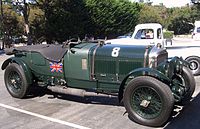Bentley Speed Six
| Bentley 6½ Litre & Speed Six | |
|---|---|
 Speed Six Mulliner drophead coupé 1930 original body, chassis LR2766, engine KR2698, registration GH 1517. First owner a Miss Bingham | |
| Overview | |
| Manufacturer | Bentley Motors Limited |
| Production | 1926–1930 544 produced[1][2] |
| Assembly | Cricklewood, London |
| Designer | Walter Owen Bentley |
| Body and chassis | |
| Class | rolling chassis |
| Body style | as arranged with coachbuilder by customer[3] |
| Layout | FR layout |
| Powertrain | |
| Engine | 6.5 L I6 |
| Dimensions | |
| Wheelbase | 132 in (3,353 mm)[4][5] 138 in (3,505 mm)[6] 140.5 in (3,569 mm)[5] 144 in (3,658 mm) 145.5 in (3,696 mm) 150 in (3,810 mm)[4] 151.5 in (3,848 mm) 152.5 in (3,874 mm)[4][5] |
| Chronology | |
| Successor | Bentley 8 Litre |
The regular Bentley 6½ Litre and the high-performance Bentley Speed Six were rolling chassis[3] in production from 1926 to 1930. The Speed Six, introduced in 1928, would become the most successful racing Bentley. Two Bentley Speed Sixes became known as the Blue Train Bentleys after their owner Woolf Barnato's involvement in the Blue Train Races of 1930.
Contents
1 Background
2 Prototype race
3 6½ Litre
4 Speed Six
4.1 Factory racing cars
5 Production
6 Gallery
7 Notes
8 References
Background
By 1924, Bentley decided to build a larger chassis than the 3 Litre, with a smoother, more powerful engine. The new chassis would be more suitable for the large, heavy limousine bodies that many of his customers were then putting on his sports car chassis, and the resulting car would be more refined and better suited for comfortable general motoring.[1][7][8]
Prototype race
Bentley built a development mule with a 4¼ L straight-six engine[7][8] derived from the 3 Litre's four cylinder engine.[9] To disguise the car's origin, it had a large, wedge-shaped radiator[8][9][10] and was registered as a "Sun".[8][9] The chassis was given a large very light weight Weymann-type[9]tourer body built by Freestone and Webb.[7]
W. O. Bentley combined one of his road tests of the Sun with a trip to see the 1924 French Grand Prix in Lyon.[7] On his return trip to the ferry at Dieppe, W. O. encountered another disguised car at a three-way junction. W. O. and the Rolls-Royce test driver recognized each other and began racing each other along the routes nationales.[7][9] This street race continued until the Rolls-Royce driver's hat blew off and he had to stop to retrieve it.[8][9] The Sun's tyres were heavily worn when W.O. got to the ferry at Dieppe.[8]
6½ Litre

1927 Bentley 6½ Litre
with H. J. Mulliner & Co. limousine body
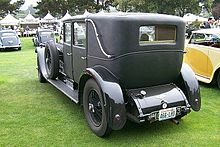
Rear view
Realizing from the impromptu race that the Sun had no performance advantage over Rolls-Royce's latest development,[7] W. O. increased the bore of his six-cylinder engine from 80 millimetres (3.1 in) to 100 millimetres (3.9 in).[8][9] With a 140 mm (5.5 in) stroke, the engine had a displacement of 6.6 L (6,597 cc (402.6 cu in))[1][9][11] Like the four-cylinder engine, Bentley's straight-6 included overhead camshaft, 4 valves per cylinder,[9] and a single-piece engine block and cylinder head cast in iron, which eliminated the need for a head gasket.[12] In base form, with a single Smiths 5-jet carburettor,[1] twin ignition magnetos,[1][8][9] and a compression ratio of 4.4:1, the Bentley 6½ Litre delivered 147 horsepower (110 kW) at 3500 revolutions per minute.[8][11]
Although based on the 3 Litre's engine, the 6½ engine incorporated many improvements. The 3 Litre's cone-type clutch[13] was replaced by a dry-plate design[5] that incorporated a clutch brake for fast gear changes,[citation needed] and the car had power-assisted[1] four-wheel brakes with finned drums. The front brakes had 4 leading shoes per drum.[citation needed] By operating a patented compensating device, the driver could adjust all four brakes to correct for wear while the car was moving, which was particularly advantageous during races.[citation needed]
A variety of wheelbases were provided ranging from 132 to 152.5 in (3,353 to 3,874 mm). The most popular wheelbase was 150 inches.[4]
Speed Six

Old Number One, winner of the 24 Hours of Le Mans in 1929 and 1930

Speed Six tourer with original body by coachbuilder Hooper
The Bentley Speed Six chassis was introduced in 1928[5] as a more sporting version of the Bentley 6½ Litre.[12] With a single-port block, two SU carburettors,[5][8][11] a high-performance camshaft,[14] and a compression ratio of 5.3:1, the Speed Six's engine produced 180 hp (130 kW) at 3500 rpm.[5][11] The Speed Six chassis was available to customers with wheelbases of 138 inches (3,505 mm),[6] 140.5 inches (3,569 mm), and 152.5 inches (3,874 mm),[5] with the 138 inch wheelbase being most popular.[6]
The Criminal Investigation Department of the Western Australia Police operated two saloon-bodied examples as patrol cars.[4]
In March 1930, Barnato raced against the Blue Train in a Speed Six with H. J. Mulliner saloon coachwork, reaching his club in London before the train was due in the station at Calais. It had generally been believed that the car in the race was a Gurney Nutting Sportsman Coupé, but the coupé had been delivered to Barnato in May 1930, more than a month after the race.[15][16]
Factory racing cars
The racing version of the Speed Six had a wheelbase of 11 feet (132 in; 3,353 mm)[5] and an engine with a compression ratio of 6.1:1 that produced 200 hp (150 kW) at 3500 rpm.[17] Successful in racing, these cars won the 24 Hours of Le Mans in 1929 and 1930[18][19] with Bentley Boys drivers "Tim" Birkin, Glen Kidston, and Woolf Barnato, the chairman of Bentley Motors.[19]
Production
- 6½ Litre: 362[1]
- Speed Six: 182[20]
Gallery
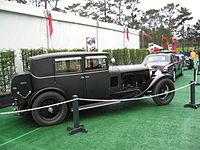
Woolf Barnato's Speed Six H. J. Mulliner saloon, in which he raced against the Blue Train
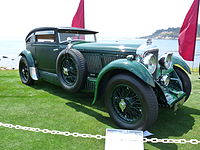
1930 Gurney Nutting Sportsman Coupé, often believed to be the car that raced the Blue Train despite being delivered to Barnato weeks after the race. Photo from 2009 Concours.

Side view
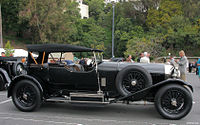
Bentley 6½ Litre Tourer

Bentley Speed Six drophead coupé
Bentley Speed Six prepared for racing

Bentley 6½-Litre Tourer

Bentley 6½-Litre Speed Six Tourer 1930
Notes
^ abcdefg Brooks 2009, p. 27.
^ Johnson 2011, p. 9.
^ ab History By Chassis – List of all W. O. Bentleys with original chassis nos. 6 1/2 Litre (Page 1)
^ abcde Brooks 2009, p. 28.
^ abcdefghi Robson 2001, p. 66
^ abc Brooks 2009, p. 31.
^ abcdef Feast 2004, p. 44
^ abcdefghij Johnson 2011, p. 8.
^ abcdefghij Posthumus 1977, p. 102.
^ Brooks 2009, p. 26.
^ abcd Culshaw & Horribin 2013, p. 81.
^ ab Robson 2001, p. 68
^ Robson 2001, p. 60
^ Feast 2004, p. 46
^ "Special Edition: Bentley Arnage Blue Train", The Car Experience
^ Young 2010.
^ Johnson 2011, pp. 8-9.
^ Culshaw & Horrobin 2013, p. 82.
^ ab Feast 2004, p. 55
^ Brooks 2009, pp. 27-28.
References
| Wikimedia Commons has media related to Bentley 6½ Litre. |
Brooks, Philip C. (2009). Carpenter, Rhonda; Iwalani, Kahikina, eds. "The Mighty Sixes". The International Club for Rolls-Royce & Bentley Owners Desk Diary 2010. Tampa, FL USA: Faircount: 26&ndash, 35..mw-parser-output cite.citationfont-style:inherit.mw-parser-output qquotes:"""""""'""'".mw-parser-output code.cs1-codecolor:inherit;background:inherit;border:inherit;padding:inherit.mw-parser-output .cs1-lock-free abackground:url("//upload.wikimedia.org/wikipedia/commons/thumb/6/65/Lock-green.svg/9px-Lock-green.svg.png")no-repeat;background-position:right .1em center.mw-parser-output .cs1-lock-limited a,.mw-parser-output .cs1-lock-registration abackground:url("//upload.wikimedia.org/wikipedia/commons/thumb/d/d6/Lock-gray-alt-2.svg/9px-Lock-gray-alt-2.svg.png")no-repeat;background-position:right .1em center.mw-parser-output .cs1-lock-subscription abackground:url("//upload.wikimedia.org/wikipedia/commons/thumb/a/aa/Lock-red-alt-2.svg/9px-Lock-red-alt-2.svg.png")no-repeat;background-position:right .1em center.mw-parser-output .cs1-subscription,.mw-parser-output .cs1-registrationcolor:#555.mw-parser-output .cs1-subscription span,.mw-parser-output .cs1-registration spanborder-bottom:1px dotted;cursor:help.mw-parser-output .cs1-hidden-errordisplay:none;font-size:100%.mw-parser-output .cs1-visible-errorfont-size:100%.mw-parser-output .cs1-subscription,.mw-parser-output .cs1-registration,.mw-parser-output .cs1-formatfont-size:95%.mw-parser-output .cs1-kern-left,.mw-parser-output .cs1-kern-wl-leftpadding-left:0.2em.mw-parser-output .cs1-kern-right,.mw-parser-output .cs1-kern-wl-rightpadding-right:0.2em
Culshaw, David; Horrobin, Peter (2013) [1974]. "Bentley". The Complete Catalogue of British Cars 1895 - 1975 (e-book ed.). Poundbury, Dorchester, UK: Veloce Publishing. pp. 80–84. ISBN 978-1-845845-83-4.
Feast, Richard (2004). The DNA of Bentley. St. Paul MN USA: MotorBooks International. ISBN 9780760319468. Retrieved 2013-12-24.
Johnson, Harvey (Fall 2011). Verschoor, Ron, ed. "The Eight-Litre: Bentley's Last is Bentley's Best". The Classic Car. Beverley Hills, CA US: Classic Car Club of America. LIX (3): 3–11. ISSN 0009-8310.
Posthumus, Cyril (1977) [1977]. The Story of Veteran & Vintage Cars. John Wood, illustrator. Feltham, Middlesex, UK: Hamlyn. p. 102. ISBN 0-600-39155-8.
Robson, Graham (2001). The Illustrated Directory of Classic Cars. St. Paul, MN USA: MBI Publishing. pp. 66–69. ISBN 0-7603-1049-1. Retrieved 2013-12-27.
- Online
Young, Eoin (26 May 2010). "Barnato, Bentley and the Blue Train Mystery – 190". New Zealand Classic Car Magazine (enthusiast's magazine). Archived from the original on 2 January 2014. Retrieved 31 December 2013.
"History By Chassis – List of all W. O. Bentleys with original chassis nos. 6 1/2 Litre (Page 1)". VintageBentleys.Org. Houston, TX USA: VintageBentleys.org. Archived from the original on 2009-04-13. Retrieved 2012-06-25.
"Special Edition: Bentley Arnage Blue Train". The Car Experience. Barrie, ON Canada: Rayda Sinni. 2005. Archived from the original on 2011-07-16. Retrieved 2012-04-09.
Bentley timeline, 1920s–present | ||||||||||||||||||||||||
|---|---|---|---|---|---|---|---|---|---|---|---|---|---|---|---|---|---|---|---|---|---|---|---|---|
Type | 1920s | 1930s | 1940s | 1950s | 1960s | 1970s | 1980s | 1990s | 2000s | 2010s | ||||||||||||||
| Ownership | Bentley Motors Limited (1919–1931) | Rolls-Royce Bentley Motors (1931) Limited (1931–1980) | Vickers plc Rolls-Royce Bentley Motors (1931) Limited (1980–1998) | Volkswagen Group (1998–) | ||||||||||||||||||||
| Coachbuilder's open 2/4 seater | 3 L | 4½ L 6½ L Speed Six | ||||||||||||||||||||||
Coachbuilder's large saloon coupé or convertible | 6½ L Speed Six 8 L | 4L 3½ 4¼L Mark V | Mark VI | R | S1 S2 S3 | T | ||||||||||||||||||
C o n t | Continental S1 Continental S2 Continental S3 | |||||||||||||||||||||||
Cars with Bentley own-factory coachwork | ||||||||||||||||||||||||
Large saloon | Mark VI | R | S1 S2 S3 | T1 | T2 | Mulsanne | Brooklands | Arnage | Mulsanne | |||||||||||||||
Turbo R | ||||||||||||||||||||||||
Coupé | Corniche | Continental R/S/T | Br. | |||||||||||||||||||||
Convertible | Corniche | Continental | Azure | |||||||||||||||||||||
Bentleys on the Volkswagen platform | ||||||||||||||||||||||||
Large saloon | Continental Flying Spur | |||||||||||||||||||||||
Coupé | Continental GT | |||||||||||||||||||||||
Convertible | Continental GTC | |||||||||||||||||||||||
SUV | Bentley Bentayga | |||||||||||||||||||||||
| ||||||||||||||||||||||||
Bentley timeline, 1921–1931 | |||||||||||
|---|---|---|---|---|---|---|---|---|---|---|---|
type /class | 1921 | 1922 | 1923 | 1924 | 1925 | 1926 | 1927 | 1928 | 1929 | 1930 | 1931 |
Sports car | 3 L | ||||||||||
4½ L & Blower | |||||||||||
Grand tourer | 6½ L & Speed Six | 4L | |||||||||
Luxury vehicle | 8 L | ||||||||||
| |||||||||||





